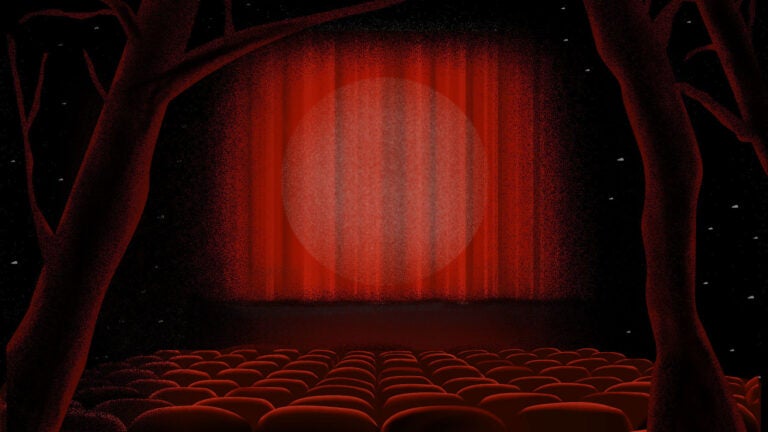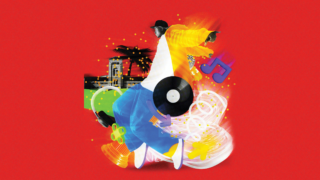
Fear can be a novelty experience, an entryway to learning about morality or a reflection of society, according to USC experts. (Illustration/Diana Molleda)
Why do we like to be scared? USC experts explain the science of fright
USC experts in neuroscience, horror films and folklore explain why being terrified can thrill and excite, and what that says about our culture
The heartbeat quickens, muscles tense and the stomach churns — all telltale signs of fear.
For some, fear is an unpleasant experience they avoid at all costs. But many others revel in the adrenaline rush of a good scare. They dash off to catch the latest horror flick or gleefully enter a haunted house to be terrorized at Halloween.
So why might we subject ourselves to these frightful ordeals? The answer lies within both the mind and the body, according to USC experts in all things spooky.
Why we like to be scared
Being petrified can be exhilarating and addictive, said Irving Biederman, a specialist in cognitive neuroscience and the Harold W. Dornsife Professor of Neuroscience at the USC Dornsife College of Letters, Arts and Sciences.
“We like novelty, something that departs from our everyday experience,” he said. “Some of the attraction of being scared comes from the deviation of having a new experience that we know is safe.”
A flood of fear paired with the relief of safety can release naturally occurring opioids like endorphins that signal pleasure, along with a hit of dopamine, a chemical linked to the brain’s reward center.
Young children can get especially excited because they don’t yet grasp that a haunted attraction or a creepy movie are just make-believe, Biederman said.
“Your amygdala will give you a fear response, an avoidance response to stay away from something that is legitimately frightful,” he said. “So, for a child, going to one of these haunted houses could be truly scary.”
That might explain why slasher films and scary stories are primarily geared toward people in their late teens and early 20s, said Tok Thompson, an associate professor of anthropology and communication at USC Dornsife.
The transition to adulthood, Thompson said, is “an interesting phase of life in which people are establishing their belief system. They are away from their parents and are often trying to test themselves, to figure out what scares them.”
Life lessons lurk in ghost and monster tales
Thompson is an expert in folklore who studies how cultures use stories about ghosts and monsters to shape personal identities and systems of morality.
Fear-inducing tales were useful in early societies as a way to teach children about natural predators like bears and wolves, he said. But as people started to ponder the meaning of life and death, their stories began to reflect that self-recognition and struggle with inner demons.
“The monsters are us, in a sense,” Thompson said. “They are that very dangerous part of us. And it’s good to recognize and be afraid of those evil parts of yourself.”
A good example of ethical guidance embedded in a scary story can be found in the Latin American tale of La Llorona. The spirit of a mother who drowned her children in a fit of jealous rage, La Llorona wails as she regretfully searches for their bodies, bringing misfortune to those who hear her cries.
La Llorona subverts the societal norm of mothers as loving and protective, Thompson said, becoming a cautionary lesson for others to consider when they get angry with their children.
Scary stories can reflect a culture’s hidden demons
Thompson teaches “Ghost Stories: Throughout Time and Across the World,” a freshman seminar at USC. In it he covers common themes in the folklore of fright across cultures.
Stories of ghosts are prevalent in most societies and often carry cultural implications. In the United States, they feature prominently in connection with slavery and the mistreatment of native tribes, like the trope of the American Indian burial ground as an explanation for supernatural events.
“We like to think of ourselves as a good society in America, and yet we’re aware of these horrible things that happened,” Thompson said. “They are still haunting us in a metaphorical sense.”
Folklore about monsters is also useful when tracking the influence of cultures as people spread across the globe, he said. Zombies are part of West African traditions, vampires have been traced back to Eastern Europe and genii likely originated in the Arabic world.
There’s an interesting role these monsters play in shaping our cultures.
Tok Thompson
“There’s an interesting role these monsters play in shaping our cultures,” he said. “And people are constantly reinventing these stories to talk about what they fear and are haunted by.”
Newer themes often deal with science, particularly the potential for technology to turn against its creator. Evil robots and smart devices that turn malevolent abound, like the computer Hal in 2001: A Space Odyssey. Thompson also noted the rise of internet monsters like Slender Man, an abnormally tall humanoid that stalks and abducts children online.
“When these new monsters come up, that shows you people aren’t too sure about some of this new technology, that maybe there is something to be frightened about,” he said.
Cinema offers window into society’s collective fears
Similar trends can be seen in recent films, said Alex Ago, a horror movie buff and director of programming and special projects at the USC School of Cinematic Arts. Modern-day thrillers often reflect fears over technological and biological experimentation, such as the accidental release of a man-made contagion in 28 Days Later.
“Horror as a genre is an expression of the collective anxieties of a society at the time in which these films are made,” Ago said. “They allow us to collectively get a sense of catharsis by the vanquishing of these fears.”
His go-to example is Godzilla, the classic 1954 sci-fi film featuring a dinosaur-like monster created by nuclear radiation. It’s a thinly veiled representation of shared anxiety in Japan about the lingering effects of the atomic attacks during World War II.
“You’ve got this nuclear monster that’s a stand-in for the bomb that rampages through a city like Tokyo,” Ago said. “It’s only by defeating Godzilla that you achieve that collective catharsis.”
Other films in the vein of Halloween and its many knockoffs and sequels, like the Friday the 13th series, tapped into growing fears in the 1980s of random acts of violence and the emergence of the serial killer in the public consciousness.
Zombie films are another illustration of this point, Ago said. A zombie movie might represent concerns about the atomic age as in Night of the Living Dead, fear of supernatural religious forces like in The Serpent and the Rainbow or a critique of mass consumerism as in Dawn of the Dead.
“Conquering the fear of death is at the core of all horror films,” he said. “It’s the way in which that problem is presented by the film that speaks to the specifics of the society at any given time.”



